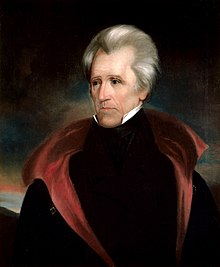Andrew Jackson
| Andrew Jackson | |
|---|---|
 |
|
| 7th President of the United States | |
|
In office March 4, 1829 – March 4, 1837 |
|
| Vice President |
John C. Calhoun (1829–1832) None (1832–1833) Martin Van Buren (1833–1837) |
| Preceded by | John Quincy Adams |
| Succeeded by | Martin Van Buren |
|
United States Senator from Tennessee |
|
|
In office March 4, 1823 – October 14, 1825 |
|
| Preceded by | John Williams |
| Succeeded by | Hugh Lawson White |
|
In office September 26, 1797 – April 1, 1798 |
|
| Preceded by | William Cocke |
| Succeeded by | Daniel Smith |
| Military Governor of Florida | |
|
In office March 10, 1821 – December 31, 1821 |
|
| Appointed by | James Monroe |
| Preceded by | José María Coppinger (Spanish East Florida) |
| Succeeded by | William Pope Duval |
| Member of the U.S. House of Representatives from Tennessee's at-large district |
|
|
In office December 4, 1796 – September 26, 1797 |
|
| Preceded by | Constituency established |
| Succeeded by | William C. C. Claiborne |
| Personal details | |
| Born |
March 15, 1767 Waxhaw Settlement between North Carolina and South Carolina, British America |
| Died | June 8, 1845 (aged 78) Nashville, Tennessee, U.S |
| Resting place | The Hermitage |
| Political party |
Democratic-Republican (Before 1828) Democratic (1828–1845) |
| Spouse(s) | Rachel Donelson (m. 1794; d. 1828) |
| Children | 3 adopted sons |
| Signature | |
| Military service | |
| Allegiance |
|
| Service/branch |
|
| Rank |
|
| Unit |
|
| Battles/wars |
American Revolutionary War • Battle of Hobkirk's Hill Creek War • Battle of Talladega • Battles of Emuckfaw and Enotachopo Creek • Battle of Horseshoe Bend War of 1812 • Battle of Pensacola • Battle of New Orleans First Seminole War Conquest of Florida • Battle of Negro Fort • Siege of Fort Barrancas |
| Awards |
Congressional Gold Medal Thanks of Congress |
| The Jackson Cabinet | ||
|---|---|---|
| Office | Name | Term |
| President | Andrew Jackson | 1829–1837 |
| Vice President | John C. Calhoun | 1829–1832 |
| None | 1832–1833 | |
| Martin Van Buren | 1833–1837 | |
| Secretary of State | Martin Van Buren | 1829–1831 |
| Edward Livingston | 1831–1833 | |
| Louis McLane | 1833–1834 | |
| John Forsyth | 1834–1837 | |
| Secretary of Treasury | Samuel D. Ingham | 1829–1831 |
| Louis McLane | 1831–1833 | |
| William J. Duane | 1833 | |
| Roger B. Taney | 1833–1834 | |
| Levi Woodbury | 1834–1837 | |
| Secretary of War | John H. Eaton | 1829–1831 |
| Lewis Cass | 1831–1836 | |
| Attorney General | John M. Berrien | 1829–1831 |
| Roger B. Taney | 1831–1833 | |
| Benjamin Franklin Butler | 1833–1837 | |
| Postmaster General | William T. Barry | 1829–1835 |
| Amos Kendall | 1835–1837 | |
| Secretary of the Navy | John Branch | 1829–1831 |
| Levi Woodbury | 1831–1834 | |
| Mahlon Dickerson | 1834–1837 | |
Andrew Jackson (March 15, 1767 – June 8, 1845) was an American soldier and statesman who served as the seventh President of the United States from 1829 to 1837 and was the founder of the Democratic Party. He was born somewhere near the then-unmarked border between North and South Carolina, into a recently immigrated Scots-Irish farming family of relatively modest means. During the American Revolutionary War, Jackson, whose family supported the revolutionary cause, acted as a courier. At age 13, he was captured and mistreated by the British army. He moved to new lands in Tennessee becoming a lawyer, planter and militia commander. He served in the U.S. House of Representatives and the U.S. Senate but was not prominent there.
In 1801, Jackson was appointed colonel in the Tennessee militia, which became his political as well as military base. He owned hundreds of slaves who worked on the Hermitage plantation. In 1806, he killed a man in a duel over a matter of honor regarding his wife Rachel. He gained national fame in the War of 1812, where he won a decisive victory over the main British invasion army at the Battle of New Orleans in the final days of the war. In response to conflict with the Seminole Indians in Spanish Florida, he invaded the territory in 1818. This led directly to the First Seminole War and the Adams–Onís Treaty of 1819, which formally transferred Florida from Spain to the United States.
Jackson ran for president in 1824. Although he got a plurality in both electoral and popular vote against three major candidates, Jackson failed to get a majority and lost in the House of Representatives to John Quincy Adams. Jackson claimed that he lost by a "corrupt bargain" between Adams and Speaker of the House Henry Clay, who was also a candidate, to give Clay the office of Secretary of State in exchange for Adams winning the presidency. Jackson's supporters then founded what became the Democratic Party. He ran again for president in 1828 against Adams. Building on his base in the West and with new support from Virginia and New York, he won by a landslide. He blamed the death of his wife, Rachel, which occurred just after the election, on the Adams campaigners, who called her a "bigamist".
...
Wikipedia
